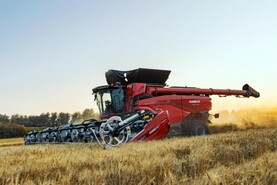Suddenly, after weeks of waiting, all the crops were ready to harvest – an early variety of seed wheat, the commercial wheat, the oats and the second crop-silage.
It seems every other farmer in the country was in the same position, as I had real difficulty getting lorries to transport the various categories of grain to the correct destination. We had to segregate the seed wheat from the commercial.
Parts of the field were badly lodged, but by skilful use of the reel and lifters, there was little left on the ground
Fortunately, my oats customer supplies its own dedicated transport, as it’s for direct human consumption. It cannot be contaminated with any other cereal, so we haven’t had to make space for it on the concrete.
From a husbandry point of view, it was the oats I was most worried about. Parts of the field were badly lodged, but by skilful use of the reel and lifters, there was little left on the ground. The patience to wait until conditions were ideal paid off, though I have yet to get any actual weights.
I went to the local Teagasc office to learn whether I was eligible for the €100/head compensation and whether it was worth applying
Meanwhile, I am astonished at the speed and technical competence the Department has shown in handling the special beef compensation package.
As I mentioned last week, I went to the local Teagasc office to learn whether I was eligible for the €100/head compensation and whether it was worth applying.
The obligation to reduce stock numbers by 5% for next year gave me pause for thought but, given the change I have to make in my new system with no bulls, I decided it made no sense to pass up the chance of collecting €10,000 in part compensation for the losses suffered. I signed my application form and off it went to the Department.
Within three days I had a form back with the nitrate output for the period from 1 July 2018 to 30 June 2019.
Also included on the form returned to me was the amount of organic nitrogen my cattle are allowed produce for the year ending June 2021
This calculation took into account the age of each individual animal during the 12-month period, as well as their individual organic N output, all multiplied by the number of animals I had during the period. It would have taken me a long time to do the sums manually.
Also included on the form returned to me was the amount of organic nitrogen my cattle are allowed produce for the year ending June 2021.
In all the hectic activity, we have had to postpone the second-cut silage. I presume and hope these few fine days will not be the only ones we get this late summer/early autumn.
Read more
Weekly weather: milder conditions ahead with intermittent showers
Application deadline looms for €100m BEAM
Suddenly, after weeks of waiting, all the crops were ready to harvest – an early variety of seed wheat, the commercial wheat, the oats and the second crop-silage.
It seems every other farmer in the country was in the same position, as I had real difficulty getting lorries to transport the various categories of grain to the correct destination. We had to segregate the seed wheat from the commercial.
Parts of the field were badly lodged, but by skilful use of the reel and lifters, there was little left on the ground
Fortunately, my oats customer supplies its own dedicated transport, as it’s for direct human consumption. It cannot be contaminated with any other cereal, so we haven’t had to make space for it on the concrete.
From a husbandry point of view, it was the oats I was most worried about. Parts of the field were badly lodged, but by skilful use of the reel and lifters, there was little left on the ground. The patience to wait until conditions were ideal paid off, though I have yet to get any actual weights.
I went to the local Teagasc office to learn whether I was eligible for the €100/head compensation and whether it was worth applying
Meanwhile, I am astonished at the speed and technical competence the Department has shown in handling the special beef compensation package.
As I mentioned last week, I went to the local Teagasc office to learn whether I was eligible for the €100/head compensation and whether it was worth applying.
The obligation to reduce stock numbers by 5% for next year gave me pause for thought but, given the change I have to make in my new system with no bulls, I decided it made no sense to pass up the chance of collecting €10,000 in part compensation for the losses suffered. I signed my application form and off it went to the Department.
Within three days I had a form back with the nitrate output for the period from 1 July 2018 to 30 June 2019.
Also included on the form returned to me was the amount of organic nitrogen my cattle are allowed produce for the year ending June 2021
This calculation took into account the age of each individual animal during the 12-month period, as well as their individual organic N output, all multiplied by the number of animals I had during the period. It would have taken me a long time to do the sums manually.
Also included on the form returned to me was the amount of organic nitrogen my cattle are allowed produce for the year ending June 2021.
In all the hectic activity, we have had to postpone the second-cut silage. I presume and hope these few fine days will not be the only ones we get this late summer/early autumn.
Read more
Weekly weather: milder conditions ahead with intermittent showers
Application deadline looms for €100m BEAM






 This is a subscriber-only article
This is a subscriber-only article










SHARING OPTIONS: